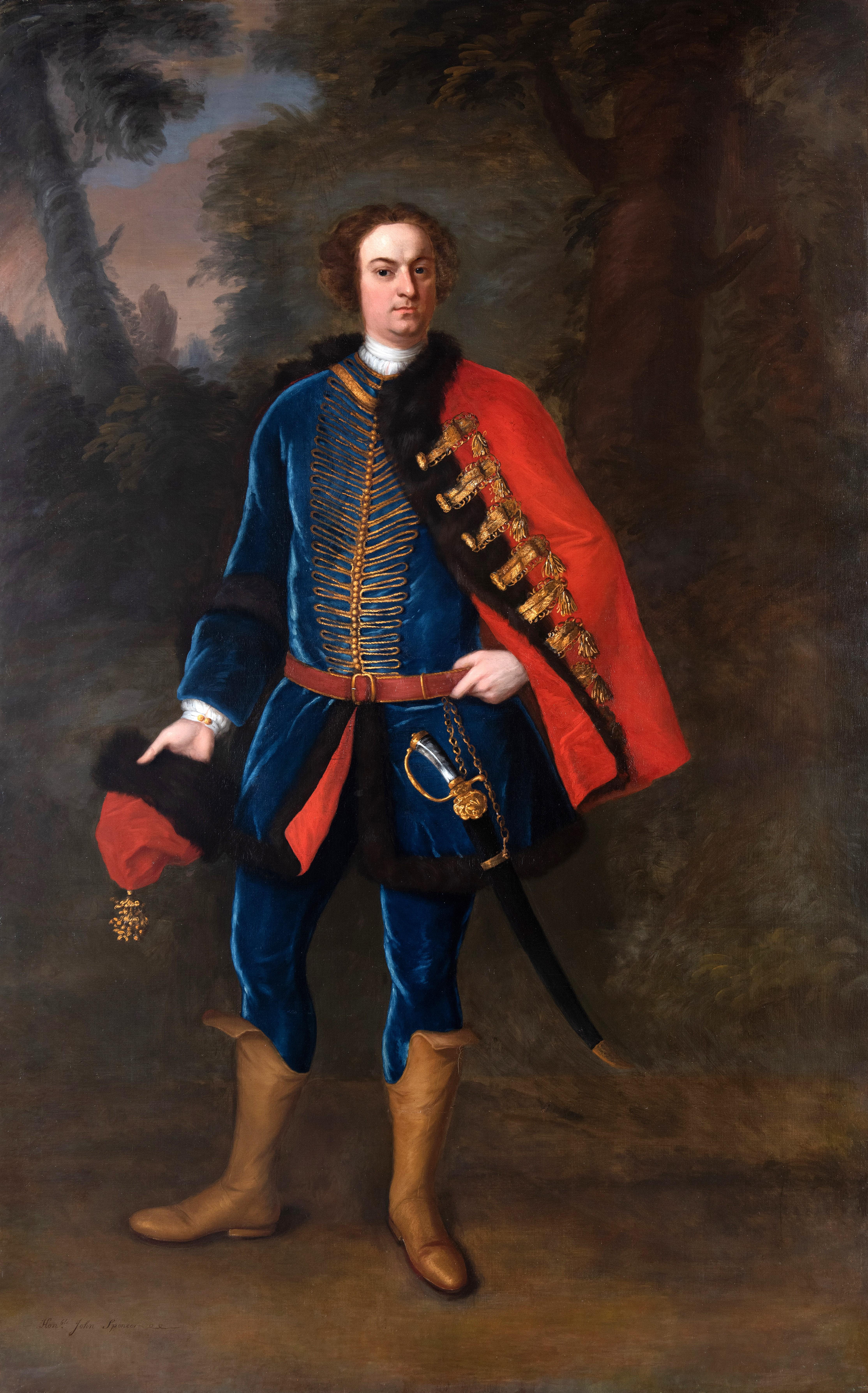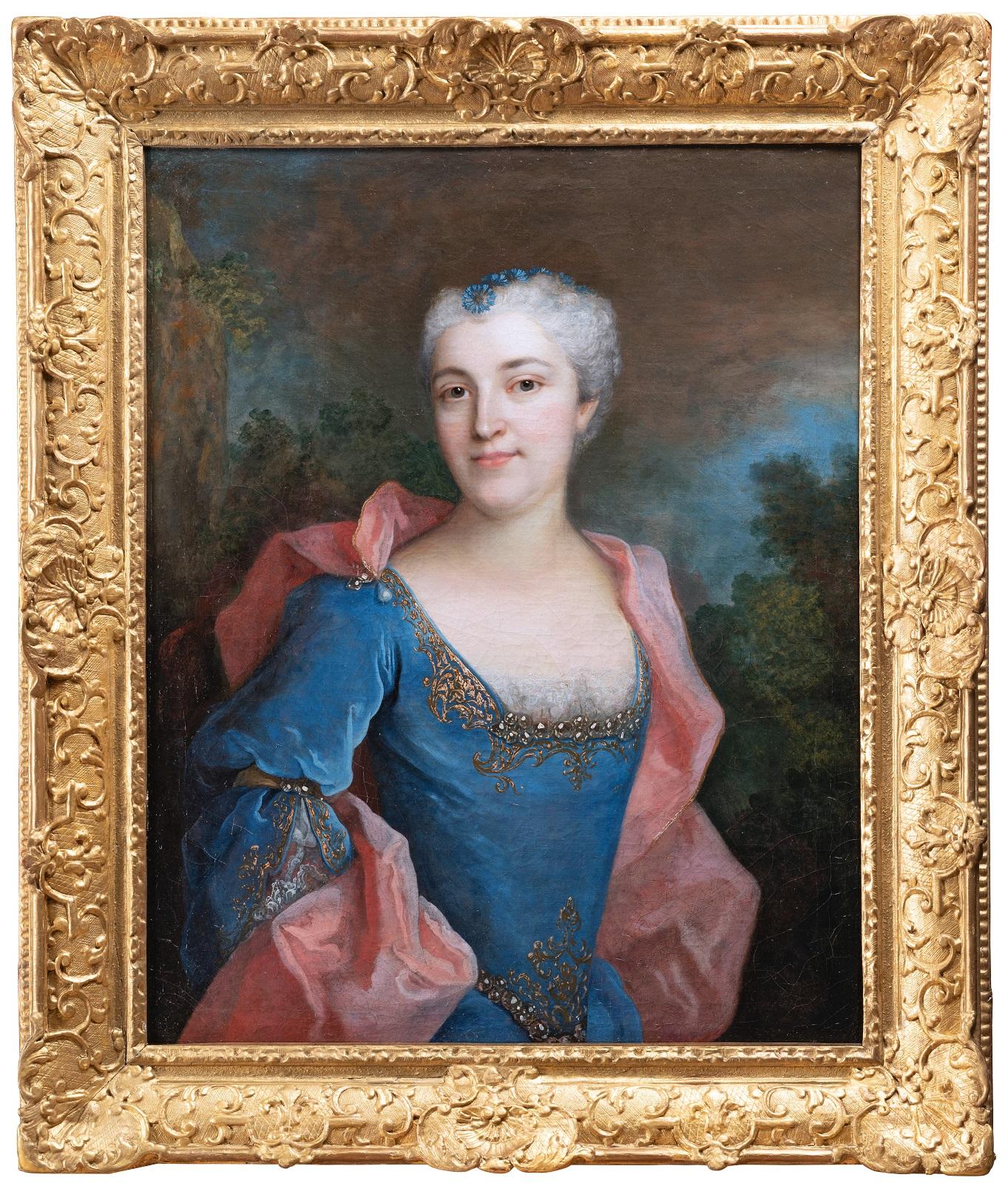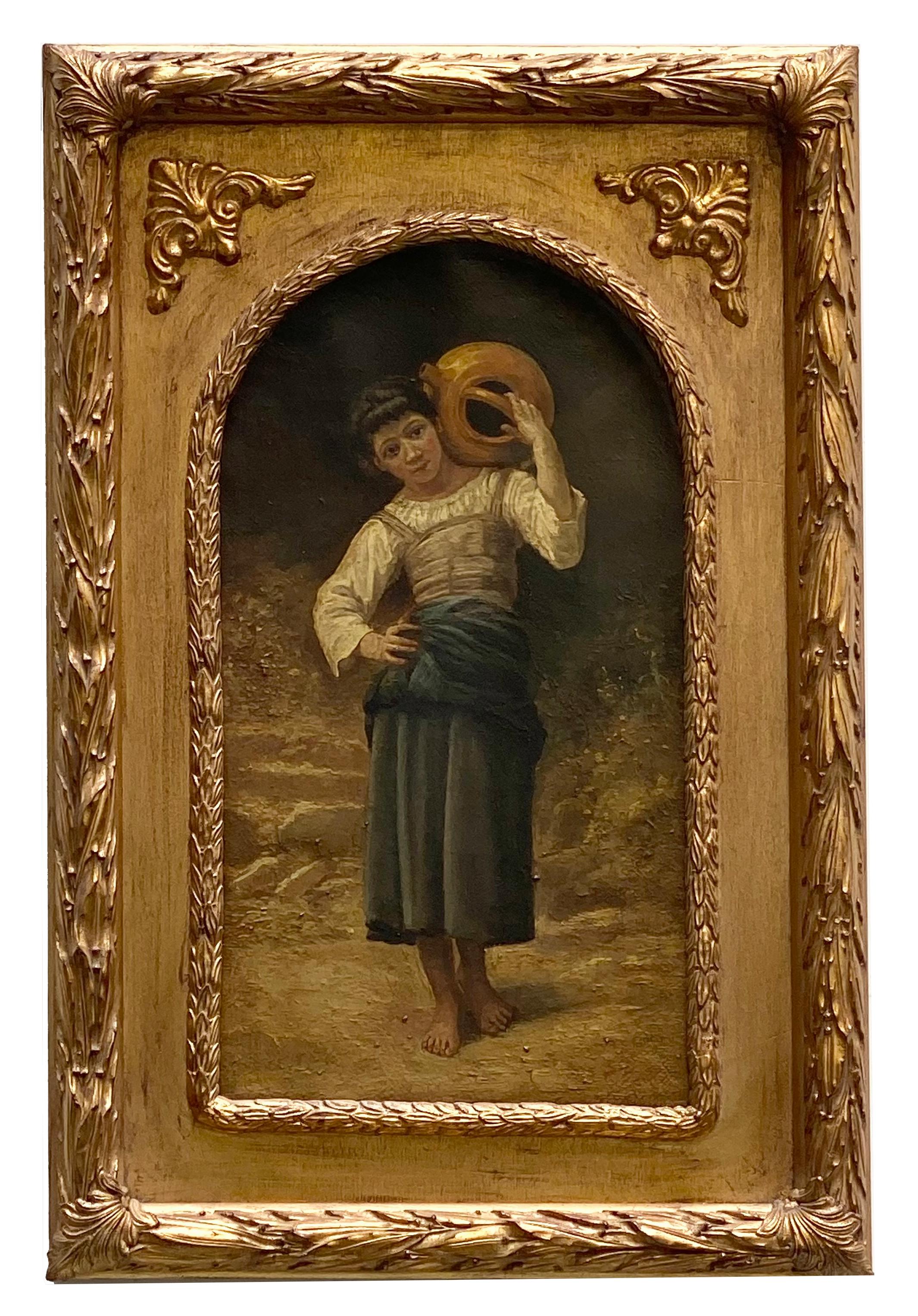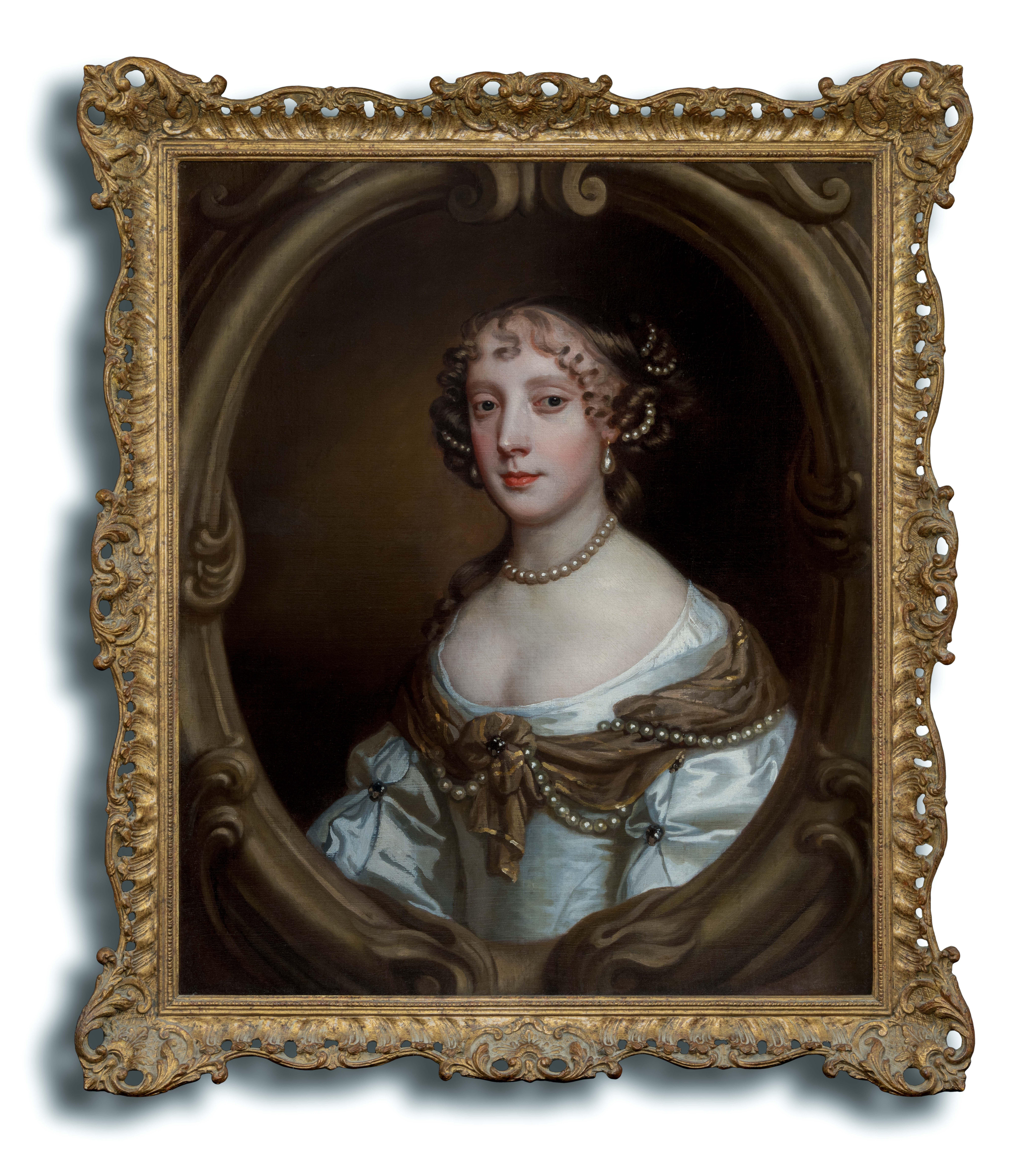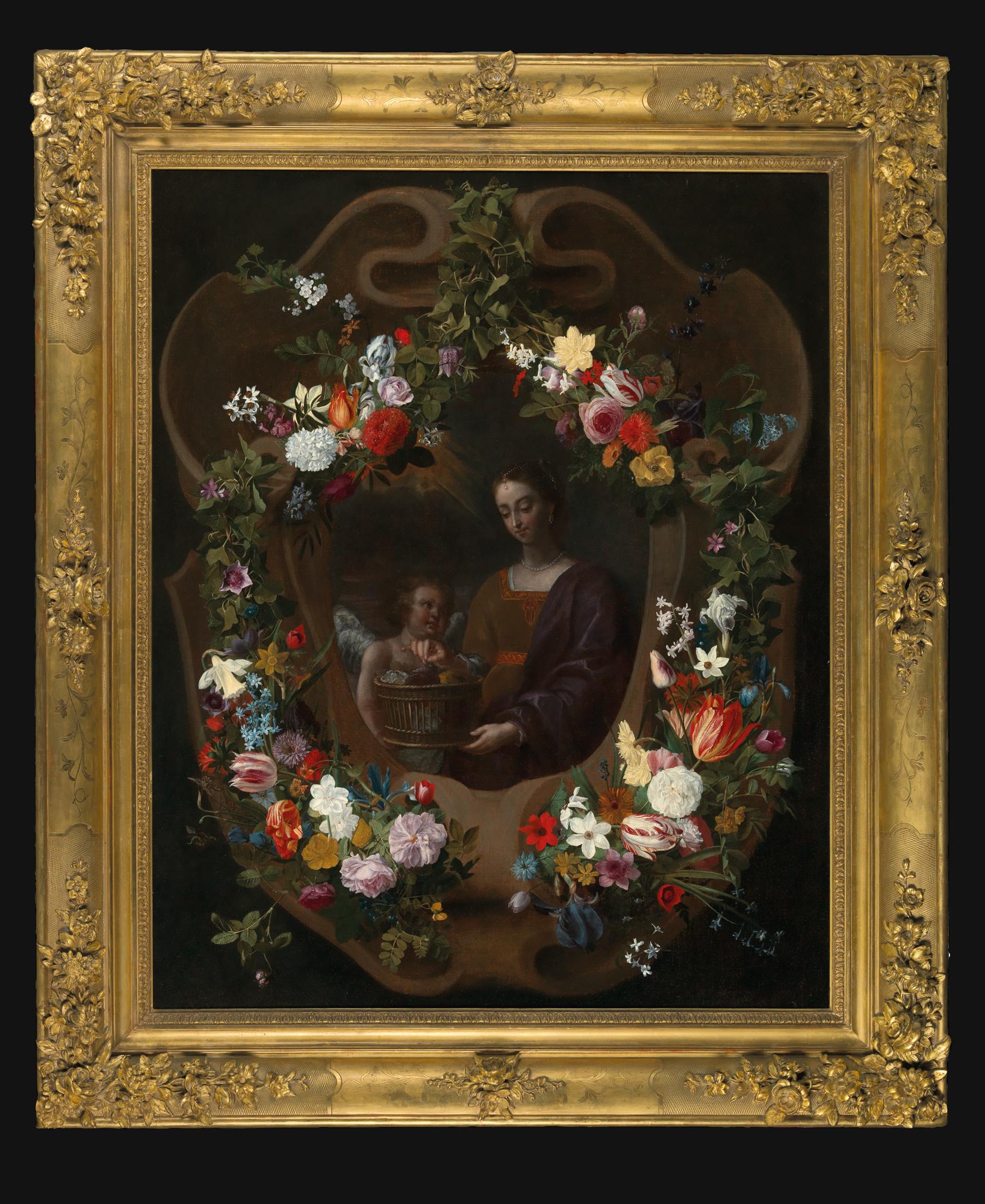Items Similar to 18th century portrait of sisters Lady Catherine and lady Jane Brydges
Want more images or videos?
Request additional images or videos from the seller
1 of 15
James Maubert 18th century portrait of sisters Lady Catherine and lady Jane BrydgesCirca 1730
Circa 1730
About the Item
This large double portrait depicts the sisters Lady Catherine and Lady Jane Brydges, the daughters of John Brydges, the Marquess of Carnarvon (1703-1727). They are seated on a stone ledge within in an idealised park landscape with a stone fountain on one side and sumptuous silk drapery to the other. They hold a garland of flowers by a blue silk ribbon around a lamb seated between them, a representation of romantic pastoral simplicity which was popular in English painting at the time.
Oil on canvas in a period 'Lely' panel frame with attached title plates.
Canvas: 116 x 150cm (45 1/2 x 59in)
Frame size: 137 x 172cm (54 x 67 1/2in)
Provenance: By descent through the eldest daughter Catherine to the Hoskyns branch of the family to the present day, who by marriage were also the descendants of Sir Christopher Wren.
A photograph of the painting is held in the National Portrait Gallery archive in London, dated 1955 and noted as being the property of Sir John Hoskyns, who later became a prominent politician in Thatcher's government.
Catherine (1725-1807) and Jane (1727-1776) were the daughters of John Brydges, Marquess of Carnarvon, Viscount Wilton and heir apparent to the Duke of Chandos and Catherine Tollemarche, daughter of Lionel, 3rd Earl of Dysart. Their eldest daughter, Catherine, shown wearing the russet gown with a blue mantel, married firstly William Berkeley Lyon and secondly in 1753, Edwyn Francis Stanhope of Stanwell House, Middlesex, with whom she had two children, Edwyn Francis in 1754 and Catherine in 1755. Catherine Stanhope married Sir Hungerford Hoskyns, 6th Baronet of Harewood Park, Herefordshire in 1774.
The younger daughter Jane Brydges, shown wearing a yellow silk gown, married her cousin, James Brydges of Pinner, but had no children.
James Maubert was born in Dublin in 1666, the son of a French Huguenot.
He was the pupil of Gaspar Smitz, the Dutch born artist who specialised in portraits, flowers and fruits, who came to England shortly after the Restoration in 1660 and lived in Dublin from the mid 1660's until his death in 1668.
The diarist George Vertue, who knew Maubert and who relied on him as a source for certain anecdotes concerning artists that appear in his Notebooks, states ‘Mr Maubert had his first instruction in drawing and painting from him in Dublin’.
Maubert worked for the Bathurst family, the Herberts and painted portraits of the Duchess of Bolton. As in the present portrait, two of these also demonstrate Maubert’s preference for including decorative flowers in his compositions, often using honeysuckle which was said to have been one of his favourite flowers.
Like many artists of the period, Godfrey Kneller and Michael Dahl had a marked influence on his work, acknowledged at the time by Vertue in his notebooks.
He noted that Maubert was 'a good Ingenious civil man ... he not only paints from the Life but is very skillful in painting of fruits & flowers. his draperys are well dispos'd & natural'
- Creator:James Maubert (1666 - 1746)
- Creation Year:Circa 1730
- Dimensions:Height: 53.94 in (137 cm)Width: 67.72 in (172 cm)
- Medium:
- Movement & Style:
- Period:
- Condition:
- Gallery Location:Bath, GB
- Reference Number:1stDibs: LU95214458432
About the Seller
5.0
Vetted Seller
These experienced sellers undergo a comprehensive evaluation by our team of in-house experts.
Established in 2002
1stDibs seller since 2015
37 sales on 1stDibs
Typical response time: 1 hour
Associations
The British Antique Dealers' AssociationLAPADA - The Association of Arts & Antiques DealersInternational Confederation of Art and Antique Dealers' Associations
- ShippingRetrieving quote...Ships From: Bath, United Kingdom
- Return PolicyA return for this item may be initiated within 3 days of delivery.
More From This SellerView All
- 17th century portrait of a ladyBy Nicolaes MaesLocated in Bath, SomersetPortrait of a lady richly dressed in a purple silk gown with white sleeves, a gold coloured cloak draped across one shoulder, her blonde curls worn up...Category
17th Century Old Masters Portrait Paintings
MaterialsCanvas, Oil
- A portrait of a lady and her daughter with an exotic birdBy Michael DahlLocated in Bath, SomersetA portrait of a lady three-quarter length, seated in an interior, wearing a red silk gown draped in a pink silk sash with an exotic bird perched on her hand and one arm resting on a stone plinth, her young daughter wearing a green silk gown standing at her side. Oil on canvas, housed in a period 'Lely' giltwood frame. This double portrait was painted at the height of Dahl's career in circa 1715 when Dahl had become firmly established as one of the leading portrait painters in Britain. Although the identities of the sitters are currently unknown, it is a sensitive depiction of a close and affectionate bond between a mother and daughter, with the young girl's hand resting affectionately on her mothers lap. The tamed exotic bird adds a charming decorative element which also serves to convey the high social status of the lady, given only the very wealthy would be able to own such a rare and expensive pet and the lively colouring of the bird's feathers is reflected in the colours of the sitters' silk gowns. Provenance: Private collection, London Michael Dahl (Stockholm 1659-1743 London) was born in Stockholm in Sweden and studied under Martin Hannibal (d 1741) and later with David Klöcker Ehrenstrahl. In 1682 he travelled to London, where he became acquainted with Godfrey Kneller and Henry Tilson, and in 1685 he left for Europe with Tilson, working briefly in Paris before continuing to Venice and Rome, where they stayed for about two years. In Rome Dahl converted to Roman Catholicism and gravitated towards the circle of Christina, former Queen of Sweden, who sat for him (Grimsthorpe Castle, Lincs). He returned to England with Tilson via Frankfurt and arrived in London in 1689, staying in England for the remainder of his career. During Dahl's absence, Kneller had consolidated his supremacy in London as the most fashionable portrait painter, but Dahl rapidly became Kneller’s closest competitor. His patrons probably had roots in the Swedish diplomatic circles, but it expanded as a result of his ability and his agreeable personality. His prices were lower than those of Kneller and he favoured softer, more diffused, colour tones and could respond to his sitters with sincerity and humanity. Politically, Kneller supported the ascendant Whigs while Dahl was a Tory, but they frequently painted the same sitters from both parties, and in spite of fundamental differences in technique and temperament, their work was sometimes similar in appearance. Dahl was prolific but rarely signed his work, and comparatively few of his portraits were engraved in mezzotint, the method used by Kneller to widen his reputation. By 1690 he had painted the aged Duke of Schomberg (engraved by William Faithorne) and Prince George of Denmark (London, Kensington Palace). He was ignored by William III but received commissions from Princess Anne, including one for a portrait of herself (Oakly Park, Ludlow, Salop). He also painted the future Duke and Duchess of Marlborough, and his informal portrait of the Duchess (Althorp House, Northants), formerly attributed to Kneller, is perhaps the most intimate of all images of her. During the 1690s he secured the patronage of Charles Seymour, the ‘Proud’ 6th Duke of Somerset, who ordered a series of seven full-length portraits of notable contemporary beauties from Dahl (1690s; Petworth House, W. Sussex, NT). This was originally a scheme similar to Kneller’s more famous ‘Hampton Court Beauties’, but the portraits were subsequently reduced to three-quarter-length formats. The features of the sitters are not individualized, but they possess a decorative, languorous glamour that recalls Lely rather than Kneller. Somerset gave Dahl further employment over the next 25 years. In 1698, following the death of Klöcker Ehrenstrahl, Dahl was offered the post of court painter at Stockholm, which he apparently refused, preferring to remain in London at his studio in Leicester Fields, near the Swedish legation. In about 1700 he was joined by a young compatriot, Hans Hysing, who worked with him for many years. Dahl seems not to have married until after 1708, He had a son Michael (d. 1741), also a painter, of whose work nothing is known, and two daughters. After the accession of Queen Anne in 1701, she and Prince George sat for a number of official portraits. His royal patronage ceased with Queen Anne’s death, and when Dahl refused to paint the infant Duke of Cumberland in 1722. He was suspected of Jacobite sympathies, and relations had cooled between him and the Swedish legation. However, his practice continued to prosper, and he acquired another important patron in Edward Harley, 2nd Earl of Oxford, who shared his political views and whose circle included the architect James Gibbs and the poets Matthew Prior and Alexander Pope, all of whom Dahl painted. Oxford commissioned several portraits of himself. In the earliest (1719; Welbeck Abbey...Category
Early 18th Century Old Masters Portrait Paintings
MaterialsCanvas, Oil
- Early 18th century portrait painting of Henrietta Paulet, Duchess of BoltonBy Maria VerelstLocated in Bath, SomersetPortrait of Henrietta Paulet, Duchess of Bolton, née Crofts, (c. 1682–1730), three-quarter length, standing on a colonnaded terrace wearing an ivory ...Category
Early 18th Century Old Masters Portrait Paintings
MaterialsCanvas, Oil
- 17th century portrait of a lady seated in an interiorLocated in Bath, SomersetPortrait of a Lady, traditionally believed to be Bridget Bertie (1629-1703/4), Duchess of Leeds, three quarter length, wearing an amber coloured silk gown, with an embroidered blue m...Category
17th Century Old Masters Portrait Paintings
MaterialsCanvas, Oil
- 18th century Dutch portrait of a family group in an interiorLocated in Bath, SomersetAn 18th century painting of a family group (otherwise known as a ‘conversation piece’) gathered around a table, an open door to the garden beyond. The father seated, with his son standing by his side, the mother seated, playing with a child on her lap, with another lady, possibly a maid standing behind, a Culpeper microscope...Category
18th Century Old Masters Portrait Paintings
MaterialsCanvas, Oil
- 18th century painting of the Dalbiac family in the gardens of a country houseBy Charles PhilipsLocated in Bath, SomersetThe painting depicts James (Jacques) Dalbiac, his wife Louise (ne de la Porte) and their five children, James, Charles, Louise, Marianne and Martha in the ornamental gardens of a grand country estate. The extensive gardens extend into the distance with gardeners working in the background and figures strolling through the avenues of trees. A peacock and peahen can be seen on the wall to the left and a potted orange tree to the right. Louise Dalbiac holds an orange taken from the orange tree, aluding to the family's faith and their loyalty to the protestant King William of Orange and their adopted country. The Dalbiacs were wealthy London silk and velvet merchants of French Huguenot origin who had fled France at the end of the 17th century to escape persecution for their protestant faith. England offered safe refuge and their skills and industriousness allowed them to establish one of the most successful businesses in London's Spitalfields which became a new centre of the silk trade, effectively leading to the collapse of the once dominant French silk industry. Both sons, James and Charles followed their father and Uncle into the family business, successfully growing the family's fortune and each going on to own their own country estates. A conversation piece is a genre of painting used to describe group portraits of families and friends, often depicted with their servants and family pets and set within an elegantly furnished interior or the garden of a grand country house. They were a celebration of the intimacy of family relations as well as a sign of status, property and the power of succession. The informality of conversation pieces grew popular in 18th century England, allowing the sitters to present themselves in a more relaxed pose, perhaps engaged in intellectual conversation or showing their talents or interests. In this present portrait, the Dalbiacs are shown richly dressed and and at leisure in a grand country house setting, conveying their success and cultural and social aspirations. Charles Philips (c.1703–1747) was an English artist known for painting a number of portraits and conversation pieces for noble and Royal patrons in the mid-eighteenth century. He was the son of portrait painter Richard Philips...Category
Early 18th Century Old Masters Portrait Paintings
MaterialsCanvas, Oil
You May Also Like
- The Hon. John SpencerBy John VanderbankLocated in London, GBPROVENANCE Presumably commissioned by the sitter’s father-in-law, John Carteret, 2nd Earl Granville, Haynes Park, Thence by descent, Lady Louisa Carteret , who married Thomas Thynne,...Category
Mid-18th Century Old Masters Portrait Paintings
MaterialsCanvas, Oil
- 18th c. French Portrait of Louise Dorothea von Hoffman, signed H. Millot, 1724Located in PARIS, FRHENRI MILLOT PORTRAIT OF LOUISE-DOROTHÉE VON HOFFMAN Signed “h. millot” and dated 1724 on the back of the original canvas Henri Millot, French painter (Paris, active between 1699 an...Category
Early 18th Century Old Masters Portrait Paintings
MaterialsCanvas, Oil
- COUNTRY GIRL- W.A.Bouguereau- Italian Portarit of young peasant Oil on canvasBy Pietro ColonnaLocated in Napoli, ITCountry girl - Pietro Colonna Italia 2006 - Oil on canvas cm. 45x25 Gold gilded wooden frame available on request The painting by Pietro Colonna is a free interpretation of the paint...Category
Early 2000s Old Masters Portrait Paintings
MaterialsOil, Canvas
- 18th century English portrait of the Duke of Newcastle upon his horse inBy Thomas SpencerLocated in Woodbury, CTThomas Spencer was a leading sporting and equestrian artist of the period of John Wootton and James Seymour; his art shows a considerable to debt to tha...Category
1760s Old Masters Portrait Paintings
MaterialsCanvas, Oil
- Portrait of Lady, Grace Saunderson, Viscountess Castleton Oil on canvas PaintingBy Studio of Sir Peter LelyLocated in London, GBPortrait of Grace Saunderson, Viscountess Castleton (1635-1667) c.1665-67 Sir Peter Lely and Studio (1618-1680) Titan Fine Art present this work, which formed part of a collection of family pictures and heirlooms of the Saunderson, Viscount Castleton family and their descendants, the Earls of Scarbrough, at their magnificent family seat Sandbeck Park, where the Earls still reside today almost four hundred years later. It was painted in the studio of Sir Peter Lely...Category
17th Century Old Masters Portrait Paintings
MaterialsCanvas, Oil
- Grand-Scale Old Master Garland Portrait, 17th Century, Signed & Dated, Rare workLocated in London, GBIndistinctly signed and dated In the first quarter of the 17th century a new form of flower painting was developed in Flemish painting, which, recreated by a large group of artists and workshops, would achieve considerable success throughout the century in much of Europe: the garland of flowers surrounding a central figure. Brueghel de Velurs was the initiator of this type of composition, however, it was his pupil, Daniel Seghers, who was the dominant figure in this specialised production and the creator of a prototype that would serve as a model for the numerous artists who followed in his wake. It seems undeniable that the artist of the present painting had seen the Garlands of Flowers Surrounding a Medallion Depicting the Triumph of Love by Daniel Seghers and Domenico Zampieri (now in the Musée du Louvre in Paris). In our painting, the present floral wreath encircles a carved cartouche within which sits Saint Dorothy of Caesarea and the attribute which often accompanies her in art, a basket of roses. The extremely delicate flowers have been rendered in meticulous detail, so that every species can be identified from exotic tulips to roses, irises and forget-me-nots; this obvious attention to naturalism is inherited from the Flemish manner. Each flower is so precise and refined that they are an individual study in their own right. The still-lifes are from the hand of Jan Anton van den Baren, with the central figures by another accomplished hand. Van den Baren’s arrangement of flowers would have delighted connoisseurs in both Flanders and in Vienna, where the impossibility of their all blooming at the same time of year would have been understood as a further statement of the wonder and beauty of the divine. Van den Baren worked first in Brussels, where he collaborated with Erasmus Quellinus II for the figures in his works, before moving with Archduke Leopold Wilhelm, his patron, to Vienna in 1656, where he instead worked with fellow Flemish émigré painter Nikolaus van Hoy. The iconography relates to an eighth century legend where she was presented a basket of roses by a child. In addition to the brilliance of his handling of still-lifes Van den Baren played an important art historical role as Director of Archduke Leopold Wilhelm’s Picture Gallery in Vienna, then one of the greatest collections in the world and the core of what was to become the present collection of the Kunsthistorisches Museum, Vienna. Van der Baren compiled an inventory of the collection in 1659, and his predecessor as Director of the Archduke’s Picture Gallery (when it was still housed in Flanders), David Teniers, depicted van der Baren (third from right) in his celebrated Archduke Leopold Willem in his gallery at Brussels, conserved at the Kunsthistorisches Museum. It is a shining example of the Flemish Baroque and is a very rare object indeed, considering there are only 14 paintings accepted as authentic works by this artist. We are grateful to Fred Meijer for confirming the attribution to Johannes Antonius van der Baren. A feature of this painting is its outstanding carved and gilded frame with a plethora of flowers and foliage. Titan Fine ArtCategory
17th Century Old Masters Portrait Paintings
MaterialsCanvas, Oil
Recently Viewed
View AllMore Ways To Browse
Antique Lady
Antique Portrait 18th
Antique Portrait Plates
Lady D
Portrait Of An Old Man
Sisters Portrait
Flower Lady
Lady With Flowers
Flowers For The Lady
Antique Dublin
French Portrait Of A Man Drawing
18th Century England Painting
Seated Lady
18th Century Flower Paintings
Lady Plate
James Dutch
Antique Portrait Photograph
Jane French
